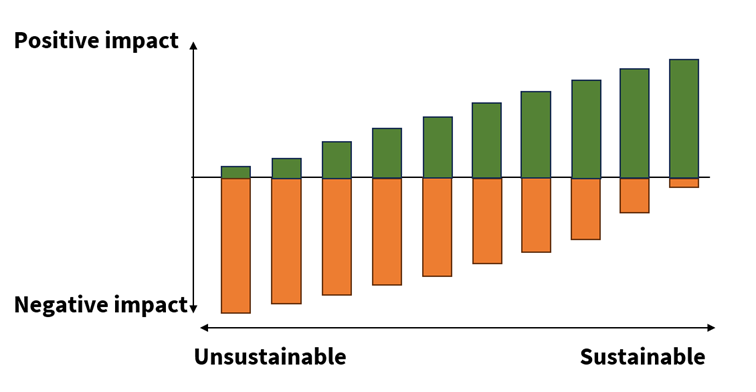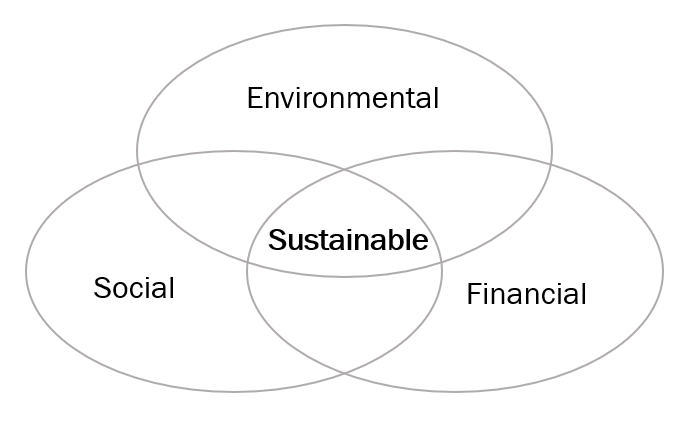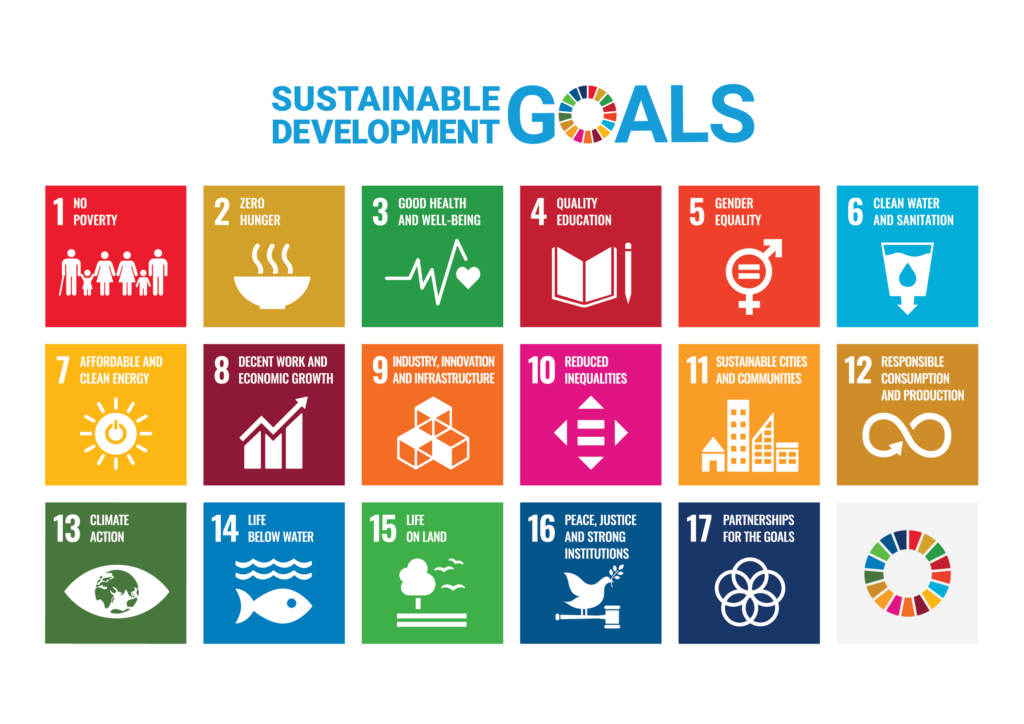What is a sustainable business?
Sustainable development is “to meet the needs of the present without compromising the ability of future generations to meet their own needs” (World Commission on Environment and Development 1987). A sustainable business works to satisfy the needs of the current society, without compromising the opportunities of future generations.
Companies can both satisfy needs and hinder the satisfaction of needs. Firms produce useful products and services, give meaning and salaries to their employees, direct profits to their owners, and support local communities and charities. Living standards have increased rapidly, with much higher incomes, longer life expectancy, and more opportunities for most people. Business has contributed to this through innovation and economic growth. At the same time, business pollutes, causes climate change, use lots of material resources, often accept harassment and inequality in the workplace, and are sometimes responsible for poor working conditions in the supply chain.
Examples of positive and negative impact
> Smoking has an extremely negative impact on people’s health and lives. Tobacco companies are essentially harming and killing their customers.
> Sharing seat-belt technology: An engineer employed by Volvo developed the three-point seat belt, which the company then patented. Instead of keeping the patent for itself to get a market advantage, Volvo shared the techology with other car companies, saving millions of lives.
> The sales of a used VHS player: Small market transactions can have positive (and negative) consequences. Read the touching thank-you note from a pensioner buying a used VHS player on Ebay.
One perspective on business sustainability is to look at the total impact of a company, product, or activity on society and the environment. How does the company contribute positively, and negatively, to needs satisfaction? To summarize its impact, a company must look at all its positive and negative effects today and in the future. I often think in the following way:
Business sustainability = Positive impact on needs satisfaction (current and future) – negative impact on needs satisfaction (current and future)
Rather than talking about “sustainable” or “unsustainable” companies, it is better to think of degrees of sustainability, from truly unsustainable to truly sustainable. The more positive and less negative impacts, the more sustainable. Figure 1-1 shows a simple model of this (inspired by Jørgensen & Pedersen 2018).

The “amount” of impact is often difficult to judge. Some actions are so bad that they get a large weight, even if they only impact very few people, and some actions are only a little positive or negative, but impact large groups.
Externalities
In economics, externalities are the effects of a market transaction on others than the buyer and seller. A classical example is pollution, which for instance influences the local air quality and health but these costs are not covered by the buyer or seller of the polluting products. These are negative externalities, but externalities can also be positive, a company developing new technology that benefits the whole society (e.g. a vaccine) will only get part of the benefits from its innovation. Many issues (but not all) in business sustainability are related to managing externalities.
Posten Bring: Sustainability in mail and parcel delivery
Posten Bring is the Norwegian postal service. The company has roots back to 1647, is fully owned by the Norwegian state and has postal delivery in Norway and logistics operations in several Nordic countries. The company has around 12 000 employees.
Posten Bring has many positive and negative impacts. They deliver postal services across all parts of Norway, even in the most remote areas, at standardized and relatively low prices. For business customers they are a trustworthy logistic partner with a large range of offerings. They offer good working conditions for their employees.
At the same time, the company has a range of negative impacts. Large trucks need plenty of energy, which so far has mainly come from fossil fuels, emitting CO2 and other pollutants. Around 1990 the company had 32 000 employees, but the change away from physical mail has made lots of employees redundant. Delivery drivers have to work on risky contracts as independent drivers.
Sources: Posten Bring annual report, Posten Bring sustainability booklet, Olsen (2022).
The social, economic and environmental dimensions of sustainable business
Sustainability in business is thought to have three dimensions: the social, economic and environmental dimensions (Elkington 1997). This is also called the triple bottom line, which is the idea that firms have three types of results – social results and environmental results, in addition to the traditional financial results.
- The environmental dimension deals with managing environmental impacts including resource use and pollution.
- The social dimension deals with managing social justice – how does the company impact employees, customers, workers and other groups in society?
- The economic dimension deals with the company’s economic impact. To be sustainable the company needs to have a healthy financial situation with enough incomes to pay the costs and an acceptable return on invested capital.
Sustainable firms manage combine the three dimensions.

Corporate social responsibility, ESG and sustainability
Sustainable business has related concepts in corporate social responsibility and ESG.
- Corporate social responsibility (CSR) has been defined as “‘the social responsibility of business encompasses the economic, legal, ethical, and discretionary [later referred to as philanthropic] expectations that society has of organizations at a given point in time” (Carroll 1979, p. 500)
- ESG stands for “environmental, social, governance” and is used mainly in finance as a term to measure sustainability performance of companies, to be used in investment decisions.
The UN sustainable development goals
In 2015, the United Nations members created 17 Sustainable Development Goals (SDGs). These goals are intended to be reached by 2030, in collaboration between governments, civil-society organizations and businesses. The aim was to contribute to “peace and prosperity for people and the planet”.

How do the goals work? Each goal has 8-12 targets attached to them. For instance, SDG 14 (Life below water), have seven outcome targets: Reduce marine pollution, protect and restore ecosystems, reduce ocean acidification; sustainable fishing, conserve coastal and marine areas; end subsidies contributing to overfishing, increase the economic benefits from sustainable use of marine resources, and three means of implementation targets: To increase scientific knowledge, research and technology for ocean health; support small scale fishers; implement and enforce international sea law. Each target has one or more indicators used to measure whether the target is reached: For instance, target 14.1 has one indicator: “Index of coastal eutrophication and floating plastic debris density”.
The UN monitors progress towards the SDGs. In the latest progress report the situation is worrying – 15% of targets are on track, 48% moderately or severely off track, and 37% are in stagnation or regression.
Many businesses use the SDGs in their sustainability activities, to focus their efforts and to communicate them to the public. The importance of business was recognized when designing the goals, but the SDGs are designed as country-level targets, and it is not clear exactly how firm should use them. The large number of targets and indicators are overwhelming and makes it easy to “cherry-pick” the targets that make the company look good. It has been suggested that firms engage in SDG-washing, by using the goals in a superficial manner without making any changes in corporate practices (Heras-Saizarbitoria et al. 2022).
Why is business not more (or less) sustainable?
Most companies have profit maximization as the goal and try to increase income and reduce costs. For instance, emitting CO2 can be done cheaply or at no cost, while renewable energy is more expensive. The cheapest labor costs are often found in countries with poor working conditions and weak labor regulation. Competition from other companies contributes to make companies choose the cheapest and least sustainable options.
Public regulation can solve this problem but is often not implemented due to competition among countries and resistance from voters and companies. Sometimes sustainable options can give higher incomes for companies, but often not enough to cover the extra costs. Also, companies sometimes lack the knowledge and internal processes to become sustainable.
On the other hand, we can also ask why companies are not even less sustainable?. Many companies make investments in sustainability with small and uncertain expectations of getting a financial return, but they still make them, due to different types of pressures from inside and outside the company, and out of concern for doing the right thing.
Reflection questions
- Name a company that you think is really sustainable. Provide reasons for why you think so.
- Posten Bring has selected the UN sustainability goals 8,9, 11,13 and 17 as particularly relevant for them. Which others could they have selected?
References
Elkington, J. (1997). Cannibals with Forks: The Triple Bottom Line of 21st Century Business. Capstone.
Carroll, A. B. (1979). A Three-Dimensional Conceptual Model of Corporate Performance. The Academy of Management Review, 4(4), 497–505. https://doi.org/10.2307/257850
Heras-Saizarbitoria, I., Urbieta, L., & Boiral, O. (2022). Organizations’ engagement with sustainable development goals: From cherry-picking to SDG-washing? Corporate Social Responsibility and Environmental Management, 29(2), 316–328. https://doi.org/10.1002/csr.2202.
Jørgensen, Sveinung, and Lars Jacob Tynes Pedersen. RESTART sustainable business model innovation. Springer Nature, 2018. https://library.oapen.org/handle/20.500.12657/23128
World commission on environment and development (1987). Our Common Future. http://www.un-documents.net/our-common-future.pdf.